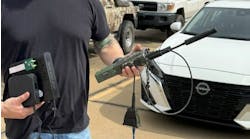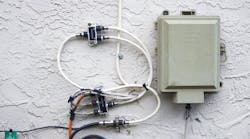The Gateway Into the Home Is Dressing Up
Have you ever thought of a network component like a network interface device (NID) as being "In" or being "Out?" We’re not talking about the fashion requirements for the box on the side of your home. Instead, we’re discussing the transition now taking place in our industry. Carriers are migrating away from being pure outside plant (OSP) players and toward taking care of the network inside customer premises as well. What other network component can explain this better than the NID, which has served as a strict demarcation point between the telco’s and the homeowner’s responsibility in the past?
Several transitions have taken place in carrier access networks over the past decades: deploying data services in addition to plain old telephone service (POTS); migrating fiber deeper into the network to deploy fiber-to-the-home (FTTH) architectures and adding video services are just a few examples. Of course, consumer bandwidth demand is facilitating this change, driven by high-speed Internet applications such as 3D online gaming and the availability of large screen LCD television sets that are already capable beyond full HD. (Just visit www.mtbs3d.com to understand what a difference 3D can make for gaming experiences. Or search for the term "Quad HDTV" to see that 1080p is just the beginning of high quality video services.)
Technological changes on the system side from digital subscriber loop (DSL) to BPON and now to GPON enable carriers to deploy a more capable and competitive network that can offer Triple (or more) Play services. Technological changes on the component side have enabled the industry to move from fiber splicing to preconnectorized solutions in the OSP and from standard single-mode to ultra bend-insensitive fiber cables in the inside plant, allowing carriers to deploy those networks more cost effectively. However, one of the biggest changes for carriers may be their migration from deploying pure OSP equipment to now managing the customer premises equipment. This evolution of ensuring a superior consumer experience has recently become even more important to maintain a provider’s customer base.
The NID’s Need for a Makeover
The NID or network terminal (NT) symbolizes all these transitions better than any other network component. Its evolution started as a "dumb" demarcation point to allow a safe connection of third party (telephone) customer premises equipment to the carrier network. It was mandated into existence, in fact, by the FCC as part of the Telecommunications Act of 1996 to allow for deregulation in the telecommunications industry.
The NID is, in principle, a rugged, thermoplastic housing with a separate compartment inside that is accessible only to the carrier for safety and security reasons. The carrier terminates the OSP (the local loop copper cable) in this compartment, which can also contain over-voltage protectors and grounding means. The homeowner’s responsibility starts at the NID but outside of the carrier’s compartment. Historically, a clear demarcation point between the OSP and the inside plant was defined because carriers chose to deploy the NID on the outside of the building (single-family or multi-dwelling unit) to ensure easy access to troubleshoot the network. Figure 1 shows an example of a NID with the carrier’s compartment and the customer premises side.
There were several steps in the evolution of the NID:
Step 1. The first evolutionary step changed how the copper cables were terminated. Insulation displacement connectivity (IDC) as a punch block to terminate the copper cables eliminated the need to strip the copper cable before connecting as required for screw terminal solutions. Alternatively, connectors (or registered jacks like the RJ-11) were used as the physical interface. However, for most carriers today, environmentally-sealed IDC terminations have become the standard.
Step 2. The next big development step was required when broadband Internet services were offered via DSL technologies. The NID layout didn’t change in principle with a carrier access section and a customer premises section, but functionality was added. Because of the necessity to separate the voice signal from the data signal, filters or splitters were integrated. The electrical requirements for these components were more complicated as DSL technologies evolved. From ADSL2/2+ to VDSL2, these technologies pushed the physical bandwidth capability of the copper plant heavily.
Step 3. The protection devices within the NID now had to ensure safe over-voltage protection while not disturbing the signal performance under normal operating conditions. In fact, the protection device’s performance has become particularly important as customer premise equipment like desktop computers or laptops, modems and printers are now connected to the carrier’s network. Thus, avoiding the liability for damaged customer equipment is very important. Hybrid (gas tube/solid-state) station protectors have proven to be the right balance between maximum, heavy-duty protection with extremely fast electrical surge response while maintaining best frequency response characteristics.
The NID Becomes "All That"
With today’s offerings of basic video services, additional functionality has become necessary. In addition to the splitter’s increase in bandwidth, converters from twisted pair to coaxial cables (balun = balanced-unbalanced impedance converters) are now an optional feature integrated into the NID. This becomes necessary because carriers must deal with different cable and connector types as they enter the customer premises.
At one time, local loop copper cables were the only medium to which providers had to tend. Now, there are CAT3 cables, CAT5/5+ data and coaxial video cables, new types of connectors, and a myriad of other challenges providers face in the home. The complexity of adding data and video applications to the carrier’s service portfolio creates the need for easier testing and troubleshooting access to ensure a satisfying consumer experience. As such, test ports, RJ-11 test jacks and subscriber bridges were developed and integrated to service this need.
In the past several years, the industry has undergone substantial consolidation. AT&T became one again after acquiring or merging SBC (which was comprised of AmeriTech, Southwestern Bell, and Pacific Telesis), BellSouth, and AT&T; Verizon brought back together Bell Atlantic and GTE and combined it with MCI. A need developed to combine all the different standards for NIDs and associated components into one solution to minimize the variety, and to ensure compatibility across the entire network footprint. In addition, as (copper) phone access lines declined, the line module capacity needs for NIDs decreased and made way for a smaller size NID. Figure 2 shows a solution of such a universal NID that can integrate high-performance modern line modules and splitters while guaranteeing backward-compatibility with components from various other vendors.
As broadband applications begin to outpace the innovation capability in copper/DSL technology, FTTH networks have evolved and deployments have accelerated. In fact, more than 13.8 million homes are passed with an FTTH network in North America, and more than 3.7 million are connected.*
FTTH allows carriers to offer a full breadth of services on a high-quality level to take advantage of the revenue opportunity without having to worry about how to deliver the required bandwidth to the home. However, it comes with a requirement to learn how to deliver the services inside of buildings and homes.
Figure 3 shows the optical networking terminal (ONT), referred to as the NID in FTTH networks. On the input or carrier side of the ONT are a fiber optic drop cable (typically a single-fiber, preconnectorized flat drop cable, sometimes with a copper wire for toning purposes) and a power cable that supplies 24 V via a battery buffered power unit. On the output or home side are typically three interfaces:
1. POTS interface via screw or IDC terminals or an RJ-11 jack.
2. 10/100 Ethernet connectivity via RF-45 jack(s).
3. One (1) television connection via coaxial connectors.
In early stages of FTTH deployment, the carrier’s responsibility ended at the side of the house. Therefore, solutions were developed to reduce the cost of installation of the ONT there. Figure 4 shows the OptiTap® Connector technology, which reduced the time and cost to install the fiber drop cable and made it easy to place an ONT with a preconnectorized fiber drop cable. All the carrier had to do at the premises was to mount the ONT on the side of the house and connect the drop and the power supply to it.
Prepping for the Big Show
However, to ensure that consumers enjoy the services for which they pay a premium, carriers now must ensure that the cabling infrastructure inside of residential buildings can deliver the bandwidth to the customer premises equipment (CPE) without distortion. While new homes are now typically equipped with a structured wiring system and quality coaxial cables to most rooms, there is a challenge in existing homes where the cabling infrastructure is either non-existent or not good enough. Carriers offering Triple Play services have to ensure that their installers are capable of installing and troubleshooting these.
In addition, providers may also be required to attend to CPE devices such as set-top boxes or Ethernet cards and sometimes even the new HDTV set. Interestingly, these services are also becoming an additional revenue opportunity for carriers. (What Best Buy® started with their Geek Squad® is now being offered in some form by carriers, too (e.g., the Embarq® RescueITSM service program).
In multi-dwelling units (MDU), carriers face an even tougher challenge. As the distances from the outside wall of the building often exceed the bandwidth capability of a structured wiring system, optical fiber cables are now installed all the way to, and sometimes even inside, the apartment or condominium. Installers want to handle the fiber optic cables just like copper communication cables.
Bend-insensitive fibers like Corning’s ClearCurve® fiber with a minimum fiber bend radius of 5 mm (less than .25 inch) in rugged drop and riser cables are available now to do exactly that. They can be installed without micro-ducts, stapled and bent around tight corners without significant signal degradation, and are backwards-compatible with the installed base of standard single-mode fibers and connectors, factory- or field-installable.
Now the next big transition may be placing the ONT inside the home. Since carriers already must enter the home to install or troubleshoot the set-top box or other CPE devices, this big paradigm shift in the carrier’s deployment philosophy could be right around the corner. Placing the ONT inside an environmentally-controlled location may reduce the cost and increase the lifetime of the electronics and its power supply and backup battery.
Fiber optic cables are small, even if they come preterminated with a hardened connector. Only a small 1- to 1.25-inch hole has to be drilled to route the OSP cable to the ONT inside the home. In addition, only one (1) fiber optic cable has to be routed to the inside of the home vs. twisted pair CAT3 for phone, twisted-pair CAT5/5e for Internet, and coaxial cable for video services if the ONT or copper NID is placed on the outside wall of the home.
So being "In" or "Out" is not a question anymore. With the trend to service customers inside the home and the cost advantages for the electronics and power supply, the good old NID will soon move indoors as an ONT, serving as the new gateway to the home.
Dr. Bernhard Deutsch is the director of marketing and market development for Corning Cable Systems. He has more than 15 years of experience in the telecommunication industry. For more information, visit www.corning.com/cablesystems.
Endnote:
* Based on recently published data from Render, Vanderslice, and Associates (RVA). www.opinionsnow.com/RVA/index.html.








